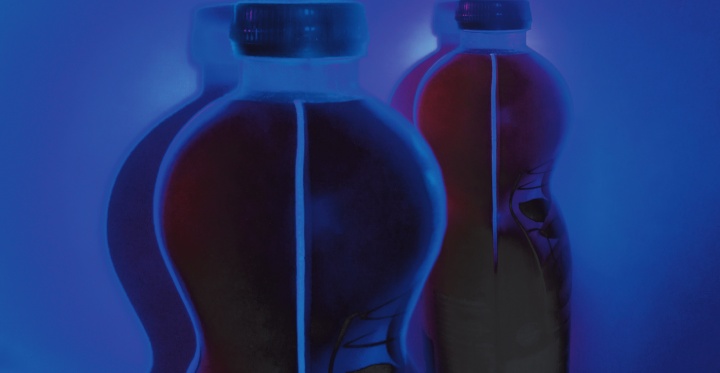Home » Sleeve adhesive for film: PET, PVC, OPS…

We manufacture different formulations of our Sleeve Ibeslab© adhesive for the formation of shrink sleeve depending on the type of film used such as PET, PVC, OPS, PP and PLA. We have references that are suitable for different types of material, being very convenient to unify in one or two types to reduce inventory and machine changes.
Our Sleeve Ibeslab adhesive incorporates a special additive to automatically inspect the correct application of the product.
This additive is invisible to the human eye and functions as an optical marker when exposed to a special ultraviolet light. Most sleeve forming machines on the market incorporate this system that allows inspection of the film seam after processing.
Ibeslab has developed sleeve adhesive formulations for the gluing of different types of film that work with the machines on the market.
The choice of the type of plastic to manufacture the sleeve depends mainly on the type of plastic with which the primary packaging is made, seeking compatibility so that they can be recycled together.
Sleeve PET, manufactured in PETG film, is the most popular and in demand. Although Sleeve PVC continues to have applications in various types of packaging. Its ease of recycling and good properties of transparency and resistance have helped its rapid growth in this variety of packaging.
In the line of making the shrink sleeve in the same type of plastic packaging is often found in the market other types of film:
The choice of printing system depends on the run length and productivity: Rotogravure, Flexography, Offset and Digital Printing are the most appropriate systems.
Print quality is very high in all four technologies and it is difficult to appreciate the differences unless you are an expert eye.
UV, solvent or water-based inks can be used, although it is advisable to make a print reserve to avoid interference with the adhesive in the area where the film is to be bonded.
Sleeve Adhesive is designed to dry at the speed that automatic sleeve forming equipment produced by leading manufacturers such as DCM, Accraply, Enprom, Karville and others work.
Our products work well in the different application systems that manufacturers incorporate in their formers such as needle, cannula, roller or others.
The appropriate Ibeslab© adhesive sleeve range will depend on the type of plastic, the processing speed and the thickness of the plastic film. As film thicknesses are becoming increasingly thinner (less than 50 microns), we have developed new formulations to prevent the adhesive from penetrating the thin film layer.
The small amount of product to be applied, as well as the width of the seam, may vary according to the label design and the performance of the converting equipment. For each installation, it is advisable to test the adhesion and adjust the evaporation rate if necessary.
The success of the film sealing process depends on variables that the machine operator must control for each type of film used to make the sleeve. Sometimes the type of machine or plastic substrate used may limit the speed of the machine and it may be necessary to use a different type of Ibeslab© sleeve adhesive formulation, so we have products with a different drying speed to give stability to the sealing.The machines allow to regulate the dosage of the product, as well as the speed, but when these variables are not enough to ensure a good bonding the drying speed of the product faster or slower in some cases can help to obtain a good result.
The degree of evaporation of the solvents we have established in a range of 1 to 10, being 1 slow drying and 10 very fast.For the gluing seam to have a high resistance, it is recommended that the film surfaces where the gluing seam is going to be made have a “print reserve” where there is no ink that could interfere with the gluing process.We have formulations that work in situations where there is a primer or inks, but a previous test is recommended in each case.Another recommendation is that the film be free of additives or compounds used in the extrusion process that may interfere with the proper functioning of the adhesives.
Our “ready-to-use” formulations ensure a stable mixture, (as long as proper storage and handling advice is respected) allowing our customers to avoid handling and mixing of flammable and hazardous chemical compounds.
Our R&D department develops products that are friendly to occupational health and the environment. Do not hesitate to contact us for advice on choosing the right sleeve adhesive for your business.
Yes, the ibeslab ID055 reference has been tested with the .030 primer, which is very popular in these machines for printing films, and it works properly.
If it is not possible to reduce the dosing quantity, the solution would be to use an adhesive adapted to thin films (less than 45 microns) such as the Ibeslab© ID067 or LP357 sleeve adhesive references developed for PET and PVC.
Yes, because the film manufacturer must control the quality of the recycled material used and the percentage used in the extrusion process.
Yes, we have products that work with different types of material.
Contact Us
If you want us to contact you or have any questions we will be happy to assist you.
Ibes Gestión y Desarrollo, S.L.
Cádiz, 20 – Pol. Ind. L’Alfaç II
03440 IBI – Alicante (España)